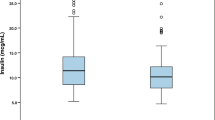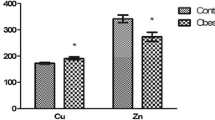Abstract
This study aims to investigate the association of serum concentrations of magnesium (Mg), selenium (Se), chromium (Cr), and copper (Cu) with cardiometabolic risk factors and liver functions in Iranian children and adolescents. This case-control study was conducted under a national surveillance program. It comprised 320 students, aged 10–18 years, in two groups of equal number with or without metabolic syndrome (MetS). Serum concentrations of Mg and abovementioned trace elements were measured by atomic absorption spectrophotometry. Median regression analysis and different models of logistic regression were used to determine the associations of these elements with cardiometabolic risk factors. In the MetS group, the median of Mg, Se, Cr, and Cu was lower or equal to controls. Mg had significant inverse association with some MetS components; however, the corresponding figure was stronger for the simultaneous association of Mg, Se, Cr, and Cu with MetS components. The binary logistic regression revealed that Mg was a significant protective factor against MetS (P = 0.0001). Likewise, by considering the simultaneous association of Mg, Se, Cr, and Cu with MetS, Se was a significant protective factor against MetS. The corresponding figures were not significant for Cr and Cu. Se and Cu had significant inverse association with liver enzymes. The protective role of Mg and Se against MetS and liver enzymes, as well as the associations of these elements with some cardiometabolic risk factors and liver enzymes in the pediatric age group should be considered in future preventive and interventional studies.
Similar content being viewed by others
References
Carlson JJ, Eisenmann JC, Norman GJ, Ortiz KA, Young PC (2011) Dietary fiber and nutrient density are inversely associated with the metabolic syndrome in US adolescents. J Am Diet Assoc 111(11):1688–1695
Bian S, Gao Y, Zhang M, Wang X, Liu W, Zhang D et al (2013) Dietary nutrient intake and metabolic syndrome risk in Chinese adults: a case-control study. Nutr J 12:106
Xue P, Gao P, Li Y (2012) The association between metabolic syndrome and bone mineral density: a meta-analysis. Endocrine 42(3):546–554
Kelishadi R, Askarieh A, Motlagh ME, Tajadini M, Heshmat R, Ardalan G et al (2013) Association of blood cadmium level with cardiometabolic risk factors and liver enzymes in a nationally representative sample of adolescents: the CASPIAN-III study. J Environ Publ Health 2013:142856
Efstathiou SP, Skeva II, Zorbala E, Georgiou E, Mountokalakis TD (2012) Metabolic syndrome in adolescence: can it be predicted from natal and parental profile? The Prediction of Metabolic Syndrome in Adolescence (PREMA) study. Circulation 125(7):902–910
Johnson WD, Kroon JJ, Greenway FL, Bouchard C, Ryan D, Katzmarzyk PT (2009) Prevalence of risk factors for metabolic syndrome in adolescents: National Health and Nutrition Examination Survey (NHANES), 2001-2006. Arch Pediatr Adolesc Med 163(4):371–377
Kelishadi R (2007) Childhood overweight, obesity, and the metabolic syndrome in developing countries. Epidemiol Rev 29:62–76
Weiss R, Dziura J, Burgert TS, Tamborlane WV, Taksali SE, Yeckel CW et al (2004) Obesity and the metabolic syndrome in children and adolescents. N Engl J Med 350(23):2362–2374
Sarrafzadegan N, Kelishadi R, Siadat ZD, Esmaillzadeh A, Solhpour A, Shirani S et al (2010) Obesity and cardiometabolic risk factors in a representative population of Iranian adolescents and adults in comparison to a western population: the Isfahan Healthy Heart Programme. Publ Health Nutr 13(3):314–323
Barbagallo M, Dominguez L (2012) Magnesium and the cardiometabolic syndrome. Curr Nutr Rep 1(2):100–108
Mohammadi F, Qorbani M, Kelishadi R, Baygi F, Ardalan G, Taslimi M et al (2014) Association of cardiometabolic risk factors and hepatic enzymes in a national sample of Iranian children and adolescents: the CASPIAN-III study. J Pediatr Gastroenterol Nutr 58(4):463–468
Song CH, Choi WS, Oh HJ, Kim KS (2007) Associations of serum minerals with body mass index in adult women. Eur J Clin Nutr 61(5):682–685
Fransson GB, Lonnerdal B (1983) Distribution of trace elements and minerals in human and cow's milk. Pediatr Res 17(11):912–915
Vaughan MA, Baines AD, Templeton DM (1991) Multielement analysis of biological samples by inductively coupled plasma-mass spectrometry. II. Rapid survey method for profiling trace elements in body fluids. Clin Chem 37(2):210–215
Stranges S, Galletti F, Farinaro E, D'Elia L, Russo O, Iacone R et al (2011) Associations of selenium status with cardiometabolic risk factors: an 8-year follow-up analysis of the Olivetti heart study. Atherosclerosis 217(1):274–278
Lecube A, Baena-Fustegueras JA, Fort JM, Pelegrí D, Hernández C, Simó R (2012) Diabetes is the main factor accounting for hypomagnesemia in obese subjects. PLoS One 7(1):e30599
Lukaski HC, Klevay LM, Milne DB (1988) Effects of dietary copper on human autonomic cardiovascular function. Eur J Appl Physiol Occup Physiol 58(1–2):74–80
Lutsenko S (2010) Human copper homeostasis: a network of interconnected pathways. Curr Opin Chem Biol 14(2):211–217
Gupta A, Lutsenko S (2009) Human copper transporters: mechanism, role in human diseases and therapeutic potential. Future Med Chem 1(6):1125–1142
Rayman MP (2000) The importance of selenium to human health. Lancet 356(9225):233–241
Stranges S, Navas-Acien A, Rayman MP, Guallar E (2010) Selenium status and cardiometabolic health: state of the evidence. Nutr Metab Cardiovasc Dis: NMCD 20(10):754–760
Albarracin C, Fuqua B, Geohas J, Juturu V, Finch MR, Komorowski JR (2007) Combination of chromium and biotin improves coronary risk factors in hypercholesterolemic type 2 diabetes mellitus: a placebo-controlled, double-blind randomized clinical trial. J Cardiometabolic Syndr 2(2):91–97
Cefalu WT, Hu FB (2004) Role of chromium in human health and in diabetes. Diabetes Care 27(11):2741–2751
Kelishadi R, Heshmat R, Motlagh ME, Majdzadeh R, Keramatian K, Qorbani M et al (2012) Methodology and early findings of the third survey of CASPIAN study: a national school-based surveillance of students’ high risk behaviors. Int J Prev Med 3(6):394–401
(2004). The fourth report on the diagnosis, evaluation, and treatment of high blood pressure in children and adolescents. Pediatrics;114(2 Suppl 4th Report):555-76.
Kelishadi R, Ardalan G, Gheiratmand R, Adeli K, Delavari A, Majdzadeh R (2006) Paediatric metabolic syndrome and associated anthropometric indices: the CASPIAN Study. Acta Paediatr (Oslo, Norway : 1992) 95(12):1625–1634
Cook S, Weitzman M, Auinger P, Nguyen M, Dietz WH (2003) Prevalence of a metabolic syndrome phenotype in adolescents: findings from the third national health and nutrition examination survey, 1988-1994. Arch Pediatr Adolesc Med 157(8):821–827
(2002). Third Report of the National Cholesterol Education Program (NCEP) Expert Panel on Detection, Evaluation, and Treatment of High Blood Cholesterol in Adults (Adult Treatment Panel III) final report. Circulation;106(25):3143-421
Genuth S, Alberti KG, Bennett P, Buse J, Defronzo R, Kahn R et al (2003) Follow-up report on the diagnosis of diabetes mellitus. Diabetes Care 26(11):3160–3167
Galli-Tsinopoulou A, Maggana I, Kyrgios I, Mouzaki K, Grammatikopoulou MG, Stylianou C, Karavanaki K (2014) Association between magnesium concentration and HbA1c in children and adolescents with type 1 diabetes mellitus. J Diabetes 6(4):369–377
Huerta MG, Roemmich JN, Kington ML, Bovbjerg VE, Weltman AL, Holmes VF et al (2005) Magnesium deficiency is associated with insulin resistance in obese children. Diabetes Care 28(5):1175–1181
He K, Liu K, Daviglus ML, Morris SJ, Loria CM, Van Horn L et al (2006) Magnesium intake and incidence of metabolic syndrome among young adults. Circulation 113(13):1675
Lima ML, Cruz T, Rodrigues LE, Bomfim O, Melo J, Correia R et al (2009) Serum and intracellular magnesium deficiency in patients with metabolic syndrome—evidences for its relation to insulin resistance. Diabetes Res Clin Pract 83(2):257–262
Czuczejko J, Zachara BA, Staubach-Topczewska E, Halota W, Kedziora J (2003) Selenium, glutathione and glutathione peroxidases in blood of patients with chronic liver diseases. Acta Biochim Pol Engl Ed 50(4):1147–1154
Aysel Y (2010) Serum selenium concentrations in cirrhotic children. Turk J Gastroenterol 21(2):153–155
Obeid O, Elfakhani M, Hlais S, Iskandar M, Batal M, Mouneimne Y et al (2008) Plasma copper, zinc, and selenium levels and correlates with metabolic syndrome components of Lebanese adults. Biol Trace Elem Res 123(1–3):58–65
Pizent A, Pavlovic M, Jurasovic J, Dodig S, Pasalic D, Mujagic R (2010) Antioxidants, trace elements and metabolic syndrome in elderly subjects. J Nutr Health Aging 14(10):866–871
Bo S, Durazzo M, Gambino R, Berutti C, Milanesio N, Caropreso A et al (2008) Associations of dietary and serum copper with inflammation, oxidative stress, and metabolic variables in adults. J Nutr 138(2):305–310
Iqbal N, Cardillo S, Volger S, Bloedon LT, Anderson RA, Boston R et al (2009) Chromium picolinate does not improve key features of metabolic syndrome in obese nondiabetic adults. Metab Syndr Relat Disord 7(2):143–150
Cefalu WT, Bell‐Farrow AD, Stegner J, Wang ZQ, King T, Morgan T et al (1999) Effect of chromium picolinate on insulin sensitivity in vivo. J Trace Elem Exp Med 12(2):71–83
Conflict of Interest
None to declare.
Source of Support
This study is funded by Isfahan University of Medical Sciences.
Author information
Authors and Affiliations
Corresponding author
Rights and permissions
About this article
Cite this article
Kelishadi, R., Ataei, E., Motlagh, M.E. et al. Association of Serum Concentrations of Magnesium and Some Trace Elements with Cardiometabolic Risk Factors and Liver Enzymes in Adolescents: the CASPIAN-III Study. Biol Trace Elem Res 163, 97–102 (2015). https://doi.org/10.1007/s12011-014-0180-8
Received:
Accepted:
Published:
Issue Date:
DOI: https://doi.org/10.1007/s12011-014-0180-8




